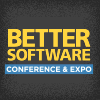Better Software Conference & EXPO 2005

PRESENTATIONS
|
Building a Winning Team: Hiring, Developing, and Nurturing Your People
With the changing landscape of software development, it is vital to select and develop people who will help your team excel. To do so, you must operate much the way a winning coach in a highly competitive sport selects and develops players with the right mix of talents and skills. Then, you need to organize the team so that the "players" are in the roles that will allow them to best contribute to the team's success. |
|
|
Choosing the Best of the Plan-Driven and Agile Development Methods
We seem to be under a curse in our profession. Although not cast by a witch or a wizard, the curse affects us just the same. It is the curse of "either/or"-the curse that we must choose either "this" or "that" but we cannot choose parts of both. Nowhere is this more evident than in today's struggle between the adherents of the traditional "plan-driven" and newer "Agile" approaches to software development. |

Lee Copeland, Software Quality Engineering |
|
Classic Mistakes in Testing: Revisited
Some common testing practices seem appealing ... but rarely seem to actually work. Yet software development organizations choose them again and again. Project behind schedule? Just shorten the testing phase! Testers pointing out too many problems with the requirements? Kick the testers out of the room! Many of the software testing gurus suggest adding new "best practices" to the test process. |

Matthew Heusser, Priority Health |
|
Cultivating High-Performing Teams
A high performance, self-governing team is a prerequisite for delivering better software products more quickly. Unfortunately, developing such a team is neither simple nor linear. It requires exceptional leadership to build and maintain a team on which everyone is focused on accomplishing a common goal. While high-performing teams may appear "headless," managing a collected group of experts requires a role typically more associated with a relationship manager than a project manager. Based on her consulting experiences and on Dr. |
|
|
Cut the Cards When You Play for Money: Overcoming Resistance to Risk Management
In most organizations, the project game is not going particularly well-we continue high stakes wagers on business projects, but lose more often than we win. Sometimes the losses are staggering. Risk management practices have received increasing attention recently as a way to improve the odds, but there are limits to what risk management can do for an organization in the absence of committed executive sponsors. |

Payson Hall, Catalysis Group Inc |
|
Defect Prediction with Reliability Growth Modeling
Although typically used at places like NASA, reliability growth modeling also can be used for common business and financial applications. Reliability growth modeling predicts how many defects will be in your release, how quickly your testing should uncover them, and how many will still be present after delivery. You can use this information to make ship/no-ship decisions, manage test coverage, and appropriately staff the help desk. |
|
|
Describing Software Requirements with User Stories
All projects start with needs or requirements. How those requirements are documented and expressed has a tremendous affect on the rest of the project. The technique of expressing requirements as "user stories" is one of the most broadly applicable techniques introduced by eXtreme Programming (XP). However, user stories are a valuable approach on all time-constrained projects, not just those using XP. Although user stories originated in the Agile processes, they are useful even if you are not planning to employ Agile development. |
|
|
Develop and Deliver Secure Web-based Systems
Gartner Group estimates that three-fourths of today's successful Web attacks do not happen via network security flaws but rather by entering directly through defects in application code. To thwart these attacks, you need to institute security procedures and technologies throughout the development lifecycle. Through a review of recent Web application breaches, Dennis Hurst exposes the methods hackers use to execute break-ins via the Web using security defects in the underlying code. |

Dennis Hurst, SPI Dynamics Inc |
|
Establishing a CMMI Compliant Metrics Program
Implementing a useful measurement program that also addresses the measurement requirements of the SEI CMMI® process areas can be a daunting task. Organizations pursuing Level 2 and Level 3 maturity have difficult decisions to make designing a measurement program that is both practical and fully compliant. Steve Lett describes the measurement requirements contained within the CMMI® Maturity Level 2 and 3 Process Areas (PAs). |
|
|
Getting to the Promised Land with CMMI® and CMM® Processess
In hopes of delivering better software, cheaper and faster, many organizations have implemented the Capability Maturity Model (CMM®) or the Capability Maturity Model Integrated (CMMI®) for Software. Thinking that such a successful model must work, other organizations have instituted many of these practices. Although some organizations have achieved their maturity level and improvement goals, most have seen little or no financial benefits. |
|


